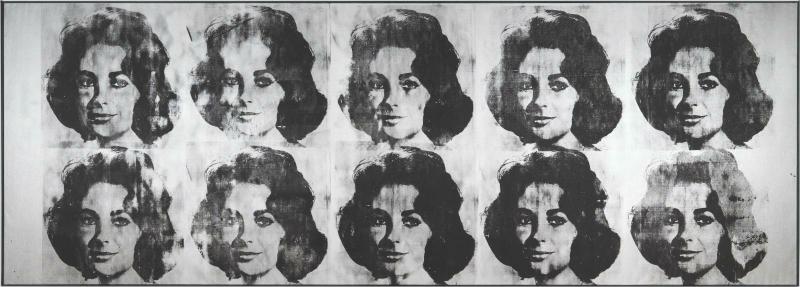
Focus on... "Ten Lizes" by Andy Warhol
After a decade of success in advertising, Andy Warhol (born Andrew Warhola) fully embraced his career as an artist in 1960, creating paintings based on comic strips. In just four or five years of intense and dazzling production, he not only became the emblematic figure of Pop art but also, through his striking understanding of the era’s structural trends, established himself as one of the most important artists of the 20th century. The large-scale painting Ten Lizes (1963) belongs to this early period when Warhol formulated the axioms of his art—principles that would influence decades to come.
I paint this way because I want to be a machine, and I feel that everything I do, I do as a machine, and that's what I want.
Andy Warhol
This pictorial surface, which American high modernism had traditionally seen as self-referential, now displays an icon of the entertainment industry, Elizabeth Taylor, who was then facing serious health issues after portraying Cleopatra in Joseph L. Mankiewicz’s eponymous (and controversial) 1963 film. The painting’s scale further reinforces its resemblance to a cinema screen. However, Warhol did not use an image from Cleopatra but rather a promotional still from Suddenly, Last Summer (1959), also directed by Mankiewicz.
Anticipating both minimalist seriality and non-composition, Warhol’s work also stands as an allegory of a world saturated with images.
Warhol employed three different images of Liz Taylor in total: the one in Ten Lizes, another of the actress as Cleopatra, and a third from National Velvet (1944), which she starred in as a child. The tension between the identity and difference of these images is central to the success of Ten Lizes. The mechanical reproduction of an image—selected but not altered by the artist—reflects the principle of indifference at the heart of Warhol’s aesthetic: the less the artist intervenes, the better the result. Anticipating both minimalist seriality and non-composition, Warhol’s work also stands as an allegory of a world saturated with images. ◼
Related articles
In the calendar
Andy Warhol, Ten Lizes (1963)
© The Andy Warhol Foundation for the Visual Arts, Inc. / Adagp, Paris
© Centre Pompidou





